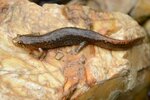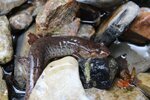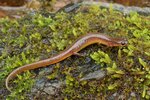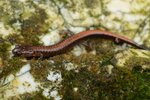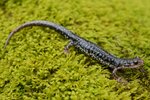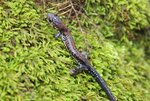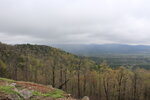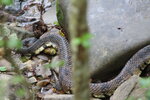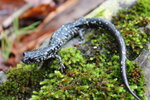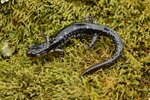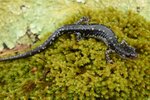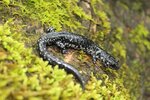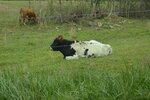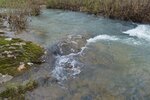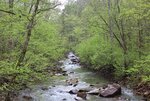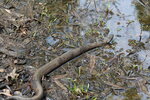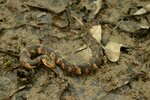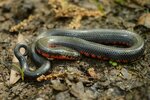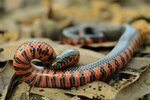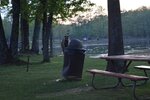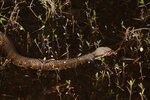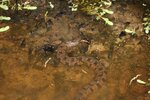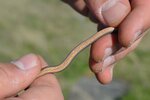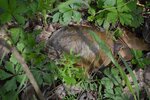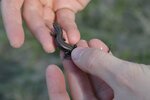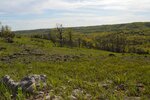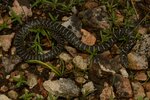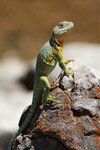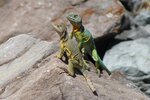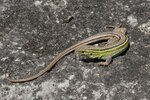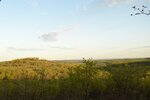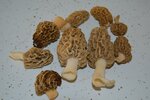Jefferson
Active member
Since last fall, we had been planning for an April offensive into the Arkansas and Oklahoma Ouachita ranges in search of the region’s endemic Plethodon and aquatic salamanders, such as Ouachita Dusky and Many-ribbed, but the pandemic called our plans into question. Thankfully, our spots were all far afield, and our local health department confirmed that we could go through with the trip so long as we self-quarantined for a few weeks afterward (which is what we were doing anyway) and tried our best to maintain six feet of distance from others—which was a cinch in the rural Arkansas mountains—we never came within 10 feet of anyone, even our Airbnb host.
Companion videos for this post:
On a foggy early April morning, we set out from Southwest Missouri on US 65 past Branson and into northern Arkansas. The earliest glimmer of morning light showed that the trees in northern Arkansas were still bare like those in Missouri. A roadside stand with a very professional-looking spider decoration declared that it sold “Coronavirus miracle killer.” Convincing. Another puzzling advertisement in Clinton, Arkansas was for a car dealership. It read: “Buy from us. Pay us.” Blunt enough. Normally, you might cushion the blow of that second sentence in an advertisement! The morning sun broke through the fog somewhere north of Conway, and as we descended from the Ozark Plateau and into the Arkansas River valley, the dogwoods, lilacs, redbuds, and deciduous trees came alive in white, purple, and vibrant light green. We were back in the South for springtime. After stopping for gas, we hit the first likely-looking park to just stretch and get our first Arkansas salamander. We did both in short order, finding about 10 Ouachita Dusky salamanders within a half-hour of rock flipping. With temperatures climbing into the high 60s, I shed my sweatshirt for the first time since October and we headed west into the craggy, steep-sloped Ouachita Mountains via the green-lined two lanes.
The mist returned upon our entrance into some of the higher lines of the Ouachitas, and I must admit, they were taller than I was expecting, very reminiscent of the Kentucky or West Virginia part of Appalachia—hills close together, steep slopes, and mixed between lush, deciduous north-facing slopes and drier, coniferous south-facing ones. However, some of the mountains in the Ouachitas are also quite cone-shaped, which made us wonder if these hills were ever active volcanoes in the distant geological past. Stepping out of the car into the mountain mist, a chill was back in the air, and we began hiking a gravel trail at the bottom of a bluff and beside a bright blue river, swollen with spring rains. Only a few rocks into the hike, we found a Caddo Mountain Salamander with the classic brassy flecking pattern—our first Arkansas endemic! It was a large specimen, about the size of an average Western Slimy, and had some red mites on its toes. Hiking deeper into the woods, we happened upon a seep emerging from the rock face just above the river, and sifting the leaf litter and cobble at the base of the spring, we happened upon a few Ouachita Duskies and a bright yellow-brown Many-ribbed Salamander, our only Eurycea target of the trip. It had bright eyes, clear costal grooves, and appeared to me very similar to the Dwarf Salamander complex in morphology. Of all the salamanders we pictured on this trip, the Many-ribbed was perhaps the most uncooperative, much like its two-lined and three-lined brethren in the East. After finally getting a few satisfactory shots of the animal, we continued along the river to another seep a quarter mile up and found a few more Many-ribbed and duskies, including a gravid female Many-ribbed that was much more photogenic than the previous animal. On our way back out, we flipped another Caddo Mountain and a few Southern red-backed salamanders, which have a curious spotty distribution in the US. So far, the trip had been euphoric, and it would only get better.
With plenty of daylight remaining, we pushed on to our west toward our most coveted species: Rich Mountain Salamander. At the first pull-out we tried, we turned up only a hibernating Copperhead and a heap of garbage thrown by drivers-by. As we continued to ascend Rich Mountain, the clouds we had seen from below became a soupy fog so thick that you couldn’t see a bear clinging to your trailer hitch! Navigation in these conditions required ample use of our phones to avoid missing the necessary turns. At our spot, the fog was just as thick. We’d have to stay within ten feet of each other, and as is our tradition for important finds, we flipped most logs together for luck. Only about thirty yards into the woods, we flipped a large Plethodon that looked different…Rich Mountain! The first one had dull coloration but a clear chestnut-colored patch on his back. A few logs later, we found a much brighter specimen with the reddish back coloration, white speckling on sides, and red spot on the cheek. My first thought upon seeing this endemic in person was that it resembles the Yonahlossee Salamander quite closely. I wonder what the evolutionary story behind this similarity, if any, is. At a small seep in the woods, we saw a few more duskies and Many-ribbed Salamanders and then got back in the car, bound forcing us to go about 25mph until we descended about a thousand feet. When we dropped back below the fog, the breathtaking beauty of the Oklahoma Ouachita range came into view—the road we traversed reminded me greatly of Virginia’s Blue Ridge Parkway, but in Oklahoma. Lines of blue-green mountains, interspersed with pines and deciduous trees, stretched into the western distance as far as we could see. Bethany said, aptly, “I never thought Oklahoma could be so pretty.” Neither did I. Even if it is just a county or two, that section of OK is gorgeous to rival anything except perhaps the Smokies and Nantahalas in Appalachia. An evening attempt to Kiamichi Slimy salamanders failed, and we were weary and hungry by this time of evening. We stopped at a much-graffitied Native American memorial and then trekked south to Broken Bow, at the terminus of the Gulf Coastal Plain, as a beautiful red-orange sunset draped across the clear-cut pine forests to our west. In Broken Bow itself, the center of the Choctaw Nation, a gas station manager told us to “stay away from the A-okay motel,” with a straight face.
After a shaky night’s sleep, we started the next morning in in search of more caudates in the piney hills of Southeast Oklahoma. Our first spot, along the banks of a large river, yielded a dead Cottonmouth, probably killed by a fisherman. A few hundred yards away in a more traditional deciduous slope microhabitat, we found an endemic—two Sequoyah slimies, one juvenile and one adult. The Sequoyah Slimy is named after the great Cherokee reformer, who invented the Cherokee alphabet and attempted, to no avail, to assimilate his tribe into Antebellum society. The salamander that bears his name is found only in McCurtain County, OK. To be honest, they look exactly like every other slimy I’ve ever encountered, but their restricted range makes finding one somewhat special. On our way out, I spotted a park ranger stepping out of his truck and thought I’d tell him about the dead snake. “Sir, pardon me. We were hiking there down all along the river and I think you’ve got someone killing your Cottonmouths.” He had a blank stare. “There was a big one dead along the river bank down there.” This didn’t seem to faze him in the slightest. In fact, he seemed to sympathize with the fisherman. The ranger burst into a hearty laugh, “Well, they just left him a-lying across the trail, did they?” He chuckled again and walked inside the building. I wonder if he killed the snake.
From here, we ventured back north into the taller Ouachita ranges and tried again for Kiamichi Slimies at a few locales. Again, we came up empty on that front, as the terrain seemed too dry to support salamanders at these museum record locations. Heading back over the mountains into Arkansas, we decided to drop our things off at our new Airbnb and then try for a Fourche Mountain Salamander in the sunny afternoon. On our way out, we encountered a Wendy’s employee who refused to return my “thank you” multiple times and sounded as if she’d rather be feeding hogs. I try not to judge, but it’s hard to notice when someone sounds less enthusiastic about their job than a Catholic bishop about the Reformation!
As we headed back into the wild green yonder, the sun beat down and temperatures hit 75. We took a small gravel road deep into the hills, going about 15mph all the way. After a first stop at a mixed forest ravine where we turned up a few slimies, we continued up the mountainside and on the top, got out to flip a series of logs that looked likely. After only a few minutes, we turned up a nice, classic-looking Fourche Mountain Salamander with the cream-colored splotches and jet black background coloration. Unbelievable! We had seen Caddo, Rich, and Fourche Mountain salamanders all within 24 hours, and this specimen was so beautiful! We found another just downslope along with a gaggle of Western Slimies and Southern Redbacks, and then riding high spirits, motored back downhill toward town on the primitive road, stopping a few times to photograph the swollen blue streams and beautiful springtime flowers and greenery. I was convinced that with temperatures nearing 80, we’d see a live Cottonmouth sunning at one of the many bridges between us and town, but they and turtles were both absent from the scene that afternoon. Our celebration upon returning to our Airbnb was to order some Pizza Hut and watch classic movies on the bigscreen TV, namely, Tom Hanks’ Money Pit and The Core. I don’t believe a pizza has ever tasted better than it did that night while watching Tom Hanks’ finances collapse in an uproarious comedy of errors.
The next morning, we decided to take one last jaunt to try to for the Kiamichi Slimy, the only Ouachita salamander to elude us to that point. The mist returned that morning and near the Oklahoma line, at our first spot, the maple and oak leaves had fully emerged bright green, with the leaf litter soaking wet from a rain the previous night. Over an hour of flipping turned up nothing here, and we headed back into Oklahoma to continue our quest for the Kiamichi. Along a beautiful creek ravine, we turned up nothing at first but some breeding Dwarf American Toads, but on the short walk back to the car, a small talus slope caught Bethany’s eye. Under the first rock we flipped was a Kiamichi Slimy! We found another a few rocks away, stopped for a minute to admire the scenery and greenery, then went on our way, with everything in the Ouachitas checked off the list, it was time to picnic and relax along the Talimena Skyway on our way back to the Airbnb. We ate some subs as vultures soared over the verdant valleys below while Bethany suggested that if we searched enough unexplored ravines in places like the Ouachitas, we’d discover a new salamander taxon. I joked, “Yeah, and new species of BEAR.” At a few pull-outs along the skyway, I played some bluegrass for our trip videos, and in front of the locomotive in Queen Wilhelmina SP, I picked and sang “Wabash Cannonball” badly enough for Johnny Cash to roll in his grave. But when you’ve just seen every single target lifer, even badly-sung songs sound good, and we motored back into town gingerly for dinner and more movies before we headed for Little Rock and then home the next day. As I told Bethany, after our Kiamichi, we could go “from the montane to the mundane” for a while and just relax.
The next morning, we started back east toward the swamps of Central Arkansas, and with high temperatures forecast for the upper 80s, we were confident that we’d see some snakes and have productive shining later that night in the muggy cypress swamps outside Little Rock. Again, the mountains and pasturelands were draped in mist as we drove east, but skies cleared near Hot Springs, where the last lines of bright green hills gave way to flatter terrain. One restaurant along the route had named itself, “The Inevitable Buffet.” Along with the car dealership from the first day of the trip, this name seemed to confirm that Arkansas business owners are the most presumptuous on the planet. The buffet wasn’t so inevitable after all, for we didn’t stop for anything but gas before hitting our first stop. We turned off the interstate and got on a little gravel road that topped a dry, low ridge before descending into swampy bottomlands. Upon parking in the gravel lot and surveying the terrain, Bethany reported that she was actually frightened to herp this spot off-trail, and I didn’t blame her one bit. If you posted a picture of this place on a Zillow for Cottonmouths, it would spark a bidding war! The heat, humidity, cypress, sunny leaf litter at water’s edge, logs out in the swamp, they all screamed “DANGER-COTTONMOUTHS!”
But we decided to give it a go anyhow, donning our snake guards and proceeding with prodding rakes to the water’s edge and into the swamp, periodically kicking submerged leaf litter in the shallows, trying to dislodge a Mud snake, Siren, or Amphiuma buried in the muck. I don’t think I’ve ever walked so slowly and deliberately while herping as we did at this spot—we watched every single step before we moved. For at least forty minutes, we saw nothing except one or two snakes out in the swamp slithering in the water—probably both Cottonmouths, but much too far to tell.
Finally, as Bethany carefully prodded around a large fallen log at the water’s edge as she got in position to kick up leaves, we got a specimen. Bethany saw it under the log, coiled—a massive, dark grey Cottonmouth! Bethany called me over, and we got pictures and video of the girthy pit viper as it escaped into the swamp. A few yards further, she raked over a medium-sized log with a handsome Broad-banded Watersnake juvenile underneath, and we took a break on a stump to wipe off the sweat, listen to the frogs, and photograph the small snake. Shortly after restarting, we encountered two more Cottonmouths at water’s edge and heard a Western Bird-voiced Treefrog calling in the cypress canopy, but with almost two hours of leaf-kicking without any of our three targets and the heat starting to get the better of us, we headed back for the car along the swamp margin. Thankfully, the mosquitoes were not out in numbers yet. Had we decided to come two weeks later, let alone in May, I cannot imagine how insufferable the bugs in that swamp would have been.
Back in the car, we weighed the trade-off between forgoing lunch for another hour or more and continuing our Mud snake hunt and going to lunch but coming back to a swamp even hotter the one we left. In the end, we decided that we’d go to another access point about a half-mile away and continue kicking for our mud snake. Upon pulling in and walking down toward the water’s edge, we spotted another coiled Cottonmouth basking in the sun, facing us. It would have made a perfect picture, but the big snake darted into the swamp before we could nab a picture. This time, instead of taking turns kicking and log rolling, we decided to try a different strategy: I’d kick and Bethany would follow behind to make sure nothing moved in the muck, and then we’d switch roles. After three or four kicks, I heard Bethany call from behind me, “Mud snake!” and pull out a navy blue and red juvenile Western Mud from the leaf pile I had kicked fifteen seconds prior. We poured some bottled water on the snake to wash the mud off for pictures and took him to higher ground for pictures and video. For those of you have never seen a mud snake, let me say that the first time you see one, three things strike you immediately: the navy blue scales on the body are so shiny, the belly and eyes of red strike such a contrast with any colors in the swamp that you wonder what the advantage of this adaption is, and lastly, they move so oddly! Taking a mud snake out of the water and watching it try to slither on hard substrate, it’s obvious you have removed the snake from its true element. Compared to any other species of snake I’ve ever observed, Farancia abacura on land is as clumsy as Inspector Clouseau! In fact, I think the saying “fish out of water” should be changed to “mud snake out of water.” We spent at least a half hour taking pictures, holding the snake, admiring its ornate coloration, and then we released it back into the edge of the swamp, watching as its red and black belly disappeared back into the muck. What a way to start lunch break!
We drove back to semi-civilization to grab something to eat. I noticed a BBQ/country kitchen place on my phone and decided to call as we gassed up in the blazing afternoon. I didn’t realize until halfway through the call that the restaurant was 50 yards behind us, across the road. In celebration of our mud snake and all the sweat that had gone into finding it, we chowed down on a huge amount of barbecue, coleslaw, cornbread, and potatoes in the parking lot—we wanted to maintain social distancing and do carry-out to minimize chance of spreading the now-ubiquitous coronavirus. On full stomachs, we drove across town to check out our Siren/Amphiuma shining locales in daylight so we’d be familiar with the terrain come nightfall.
At the first spot, a large pond with shallow edges, ample trash from lazy catfish and bass fishermen, and a mowed grass bank half way around, we spotted a Broad-banded Watersnake sticking its head up through the algae, the shell of a dead River Cooter, and in a stream that drained the lake, a whole cadre of Plain-bellied Watersnakes patrolling for fish at the small waterfalls below the dam. I tried to nab one but it got away, and when Bethany grabbed a huge specimen, it sprayed so much musk that Bethany let it go mid-air, and it landed on the opposite bank unscathed. A local passer-by in a 1980s Honda Civic saw the whole scene and stopped beside us to inform us, “You know, that was a water moccasin.” Bethany explained that it was a Plain-bellied Watersnake, not a moccasin, but she was going nowhere. “There’s moccasins down there,” he said in an ominous tone. Well, if that’s how you see it…
From there, we checked out other spot out in daylight, and this one, a smaller neighborhood pond open to the public, appeared popular with catfish enthusiasts. Several couples were fishing at intervals along the grassy banks, casting lines into the murky waters. Hopefully, with nightfall, one of these spots would yield some eel-like salamanders for us. We went back to the first spot to take a nap and await nightfall. About an hour before twilight, I started counting how many cars entered and exited, hoping that we’d have the place to ourselves soon. That hope was dashed—catfishing is apparently most productive at night, so there were still three or four groups along the shoreline by the time we were ready to begin our Amphiuma hunt. We watched a raccoon brazenly climb into a trash can fifteen feet from our car with amusement, then broke out the flashlights and cameras and walked to the shoreline. As a few mosquitoes descended on us and frogs and toads called from all around, we shined some Green frogs and Fowler’s toads in short order, and then near the border of the woods, two Western Cottonmouths, a few yards out into the pond, hunting on top of the water. Despite their potent venom and bad reputation, I must say that they are graceful swimmers, and handsome snakes generally. Reversing our direction and going behind a group of fishermen, we saw several Broad-banded and Plain-bellied Watersnakes, including the same one we sighted during the day. After an hour or so, we had covered over a half mile of shoreline, and seen hundreds of frogs and toads, at least a dozen snakes, but still no Amphiumas or Sirens. But on our way back to the car, I saw it—so huge it was impossible to miss, about fifteen feet into the pond: a massive, bi-colored Three-toed Amphiuma! I whispered, “Bethany, Amphiuma!” and she got a good look at the alien-looking, beastly salamander. It must have been at least three feet long! This specimen had a strong contrast between the grayish-black top half of the body and the creamy white belly, characteristic of the Three-toed species. He was a sight to behold, but the camera was on automatic focus and couldn’t decide what to focus on, and by the time we reset it, the big salamander had disappeared into deeper waters. We were a bit heartbroken, but also happy just to get a nice clear look at our first Three-toed Amphiuma. We stuck around for another half hour hoping he’d come back up, but he didn’t, so we proceeded to the smaller pond.
There, we were alone. The weed-choked canal leading to the pond had no snakes or salamanders, but shortly after we arrived at the pond, I saw something resembling an Amphiuma about three feet underwater. In water that murky, it’s hard to know you aren’t just seeing an optical illusion or a root or something. But when the object started moving, we scrambled to try to net the beast, but again, it got away. This one was more like two feet long. A few yards further down the shore, we spied and photographed a huge lifer Diamondback Watersnake sitting atop the aquatic vegetation. Walking around the rest of the pond yielded nothing, and it seemed something in the woods was stalking us, for I’d hear the crack of twigs or rustle of leaves and then see eye glare in my light every few minutes. It was probably just some house cats (we saw several in the daylight there), but it freaked us out nonetheless, and with a thunderstorm coming, we decided to call it a trip. We drove through some showers outside Little Rock and I gave up the wheel somewhere on the Ozark Plateau. At 2am, I woke up in our driveway, and Bethany and I stumbled inside, our awesome Arkansas adventure at its end.
That wasn’t the end of our April herping highlights, however. With me teleworking and plenty of free time, we began morel mushroom hunting on the weekends at local public parks and discovered that walking that slowly through the woods is a great way to find Three-toed Box turtles by the truckload. One day, we saw four or five. We also re-visited the glade from the early spring that gave us the Western wormsnakes, and under a huge, flat slab of dolomite, we got some Southern Coal skinks and our first Missouri Lampropeltis: Speckled Kingsnake! The juveniles of this species have speckles that aren’t white like the adults, but a neon yellow-green, like the color on athletic clothing. Later in April, the morel finding slowed down, but we still hiked regularly and continued finding common species of snakes and lizards at our favorite spots. Early in May, we tried for one of our top Missouri targets at a place a conservation officer had told me about: Eastern Collared Lizard.
It always awed Bethany and I that a lizard known primarily as a Southwestern animal, associated so closely with the mountains and desert scrub of West Texas, New Mexico, and Arizona, had a range extension into the Ozarks of Missouri and Arkansas. From a sheer microhabitat point of view, this makes perfect sense: SW Missouri gets blazing in the summer, and our treeless glades, with their abundant rock cover, tarantulas, and cacti, approximate a desert habitat, just with much more annual rainfall. But geographically, it boggles the mind. In any case, we drove down toward the Arkansas border one early May morning as the sun topped the Ozarks and began beating down. I had my doubts about this spot, since it seemed unlikely and fragmented, and thought that perhaps the conservation officer just mixed up a “Collared Lizard” with some more common type of lizard, like racerunners or the ever-present (one might say “inevitable”) Five-lined skink. But as we drove past the small talus area I was told about, two Collared Lizards sat atop one of the boulders like dinosaurs, huge, hulking lizards. Bethany freaked out! She had wanted to see one of these lizards for years, and in breeding season, the male from the pair we now observed had brilliant coloration—black bands on the neck, yellow on the head, red splashed here and there on a fluorescent green background color. The female skittered off the rock as we brought the car to a halt, took our first pictures, and then approached for some closer pictures. I couldn’t believe how close the male let us get! We got within eight or nine feet of the territorial male several times as he scurried around the rocks, while the female, while we were able to get closer than we were in the car, was significantly more wary of us. What a way to end the mid-spring herping season: with a clear transition to May and hotter temperatures with a gorgeous pair of Collared Lizards!
Happy herping, thanks for reading, and I hope you enjoy the pictures and part three!
First pictures: Ouachita Dusky Salamanders, Many-ribbed Salamander, Southern Red-backed Salamander, Caddo Mountain Salamander
Companion videos for this post:
On a foggy early April morning, we set out from Southwest Missouri on US 65 past Branson and into northern Arkansas. The earliest glimmer of morning light showed that the trees in northern Arkansas were still bare like those in Missouri. A roadside stand with a very professional-looking spider decoration declared that it sold “Coronavirus miracle killer.” Convincing. Another puzzling advertisement in Clinton, Arkansas was for a car dealership. It read: “Buy from us. Pay us.” Blunt enough. Normally, you might cushion the blow of that second sentence in an advertisement! The morning sun broke through the fog somewhere north of Conway, and as we descended from the Ozark Plateau and into the Arkansas River valley, the dogwoods, lilacs, redbuds, and deciduous trees came alive in white, purple, and vibrant light green. We were back in the South for springtime. After stopping for gas, we hit the first likely-looking park to just stretch and get our first Arkansas salamander. We did both in short order, finding about 10 Ouachita Dusky salamanders within a half-hour of rock flipping. With temperatures climbing into the high 60s, I shed my sweatshirt for the first time since October and we headed west into the craggy, steep-sloped Ouachita Mountains via the green-lined two lanes.
The mist returned upon our entrance into some of the higher lines of the Ouachitas, and I must admit, they were taller than I was expecting, very reminiscent of the Kentucky or West Virginia part of Appalachia—hills close together, steep slopes, and mixed between lush, deciduous north-facing slopes and drier, coniferous south-facing ones. However, some of the mountains in the Ouachitas are also quite cone-shaped, which made us wonder if these hills were ever active volcanoes in the distant geological past. Stepping out of the car into the mountain mist, a chill was back in the air, and we began hiking a gravel trail at the bottom of a bluff and beside a bright blue river, swollen with spring rains. Only a few rocks into the hike, we found a Caddo Mountain Salamander with the classic brassy flecking pattern—our first Arkansas endemic! It was a large specimen, about the size of an average Western Slimy, and had some red mites on its toes. Hiking deeper into the woods, we happened upon a seep emerging from the rock face just above the river, and sifting the leaf litter and cobble at the base of the spring, we happened upon a few Ouachita Duskies and a bright yellow-brown Many-ribbed Salamander, our only Eurycea target of the trip. It had bright eyes, clear costal grooves, and appeared to me very similar to the Dwarf Salamander complex in morphology. Of all the salamanders we pictured on this trip, the Many-ribbed was perhaps the most uncooperative, much like its two-lined and three-lined brethren in the East. After finally getting a few satisfactory shots of the animal, we continued along the river to another seep a quarter mile up and found a few more Many-ribbed and duskies, including a gravid female Many-ribbed that was much more photogenic than the previous animal. On our way back out, we flipped another Caddo Mountain and a few Southern red-backed salamanders, which have a curious spotty distribution in the US. So far, the trip had been euphoric, and it would only get better.
With plenty of daylight remaining, we pushed on to our west toward our most coveted species: Rich Mountain Salamander. At the first pull-out we tried, we turned up only a hibernating Copperhead and a heap of garbage thrown by drivers-by. As we continued to ascend Rich Mountain, the clouds we had seen from below became a soupy fog so thick that you couldn’t see a bear clinging to your trailer hitch! Navigation in these conditions required ample use of our phones to avoid missing the necessary turns. At our spot, the fog was just as thick. We’d have to stay within ten feet of each other, and as is our tradition for important finds, we flipped most logs together for luck. Only about thirty yards into the woods, we flipped a large Plethodon that looked different…Rich Mountain! The first one had dull coloration but a clear chestnut-colored patch on his back. A few logs later, we found a much brighter specimen with the reddish back coloration, white speckling on sides, and red spot on the cheek. My first thought upon seeing this endemic in person was that it resembles the Yonahlossee Salamander quite closely. I wonder what the evolutionary story behind this similarity, if any, is. At a small seep in the woods, we saw a few more duskies and Many-ribbed Salamanders and then got back in the car, bound forcing us to go about 25mph until we descended about a thousand feet. When we dropped back below the fog, the breathtaking beauty of the Oklahoma Ouachita range came into view—the road we traversed reminded me greatly of Virginia’s Blue Ridge Parkway, but in Oklahoma. Lines of blue-green mountains, interspersed with pines and deciduous trees, stretched into the western distance as far as we could see. Bethany said, aptly, “I never thought Oklahoma could be so pretty.” Neither did I. Even if it is just a county or two, that section of OK is gorgeous to rival anything except perhaps the Smokies and Nantahalas in Appalachia. An evening attempt to Kiamichi Slimy salamanders failed, and we were weary and hungry by this time of evening. We stopped at a much-graffitied Native American memorial and then trekked south to Broken Bow, at the terminus of the Gulf Coastal Plain, as a beautiful red-orange sunset draped across the clear-cut pine forests to our west. In Broken Bow itself, the center of the Choctaw Nation, a gas station manager told us to “stay away from the A-okay motel,” with a straight face.
After a shaky night’s sleep, we started the next morning in in search of more caudates in the piney hills of Southeast Oklahoma. Our first spot, along the banks of a large river, yielded a dead Cottonmouth, probably killed by a fisherman. A few hundred yards away in a more traditional deciduous slope microhabitat, we found an endemic—two Sequoyah slimies, one juvenile and one adult. The Sequoyah Slimy is named after the great Cherokee reformer, who invented the Cherokee alphabet and attempted, to no avail, to assimilate his tribe into Antebellum society. The salamander that bears his name is found only in McCurtain County, OK. To be honest, they look exactly like every other slimy I’ve ever encountered, but their restricted range makes finding one somewhat special. On our way out, I spotted a park ranger stepping out of his truck and thought I’d tell him about the dead snake. “Sir, pardon me. We were hiking there down all along the river and I think you’ve got someone killing your Cottonmouths.” He had a blank stare. “There was a big one dead along the river bank down there.” This didn’t seem to faze him in the slightest. In fact, he seemed to sympathize with the fisherman. The ranger burst into a hearty laugh, “Well, they just left him a-lying across the trail, did they?” He chuckled again and walked inside the building. I wonder if he killed the snake.
From here, we ventured back north into the taller Ouachita ranges and tried again for Kiamichi Slimies at a few locales. Again, we came up empty on that front, as the terrain seemed too dry to support salamanders at these museum record locations. Heading back over the mountains into Arkansas, we decided to drop our things off at our new Airbnb and then try for a Fourche Mountain Salamander in the sunny afternoon. On our way out, we encountered a Wendy’s employee who refused to return my “thank you” multiple times and sounded as if she’d rather be feeding hogs. I try not to judge, but it’s hard to notice when someone sounds less enthusiastic about their job than a Catholic bishop about the Reformation!
As we headed back into the wild green yonder, the sun beat down and temperatures hit 75. We took a small gravel road deep into the hills, going about 15mph all the way. After a first stop at a mixed forest ravine where we turned up a few slimies, we continued up the mountainside and on the top, got out to flip a series of logs that looked likely. After only a few minutes, we turned up a nice, classic-looking Fourche Mountain Salamander with the cream-colored splotches and jet black background coloration. Unbelievable! We had seen Caddo, Rich, and Fourche Mountain salamanders all within 24 hours, and this specimen was so beautiful! We found another just downslope along with a gaggle of Western Slimies and Southern Redbacks, and then riding high spirits, motored back downhill toward town on the primitive road, stopping a few times to photograph the swollen blue streams and beautiful springtime flowers and greenery. I was convinced that with temperatures nearing 80, we’d see a live Cottonmouth sunning at one of the many bridges between us and town, but they and turtles were both absent from the scene that afternoon. Our celebration upon returning to our Airbnb was to order some Pizza Hut and watch classic movies on the bigscreen TV, namely, Tom Hanks’ Money Pit and The Core. I don’t believe a pizza has ever tasted better than it did that night while watching Tom Hanks’ finances collapse in an uproarious comedy of errors.
The next morning, we decided to take one last jaunt to try to for the Kiamichi Slimy, the only Ouachita salamander to elude us to that point. The mist returned that morning and near the Oklahoma line, at our first spot, the maple and oak leaves had fully emerged bright green, with the leaf litter soaking wet from a rain the previous night. Over an hour of flipping turned up nothing here, and we headed back into Oklahoma to continue our quest for the Kiamichi. Along a beautiful creek ravine, we turned up nothing at first but some breeding Dwarf American Toads, but on the short walk back to the car, a small talus slope caught Bethany’s eye. Under the first rock we flipped was a Kiamichi Slimy! We found another a few rocks away, stopped for a minute to admire the scenery and greenery, then went on our way, with everything in the Ouachitas checked off the list, it was time to picnic and relax along the Talimena Skyway on our way back to the Airbnb. We ate some subs as vultures soared over the verdant valleys below while Bethany suggested that if we searched enough unexplored ravines in places like the Ouachitas, we’d discover a new salamander taxon. I joked, “Yeah, and new species of BEAR.” At a few pull-outs along the skyway, I played some bluegrass for our trip videos, and in front of the locomotive in Queen Wilhelmina SP, I picked and sang “Wabash Cannonball” badly enough for Johnny Cash to roll in his grave. But when you’ve just seen every single target lifer, even badly-sung songs sound good, and we motored back into town gingerly for dinner and more movies before we headed for Little Rock and then home the next day. As I told Bethany, after our Kiamichi, we could go “from the montane to the mundane” for a while and just relax.
The next morning, we started back east toward the swamps of Central Arkansas, and with high temperatures forecast for the upper 80s, we were confident that we’d see some snakes and have productive shining later that night in the muggy cypress swamps outside Little Rock. Again, the mountains and pasturelands were draped in mist as we drove east, but skies cleared near Hot Springs, where the last lines of bright green hills gave way to flatter terrain. One restaurant along the route had named itself, “The Inevitable Buffet.” Along with the car dealership from the first day of the trip, this name seemed to confirm that Arkansas business owners are the most presumptuous on the planet. The buffet wasn’t so inevitable after all, for we didn’t stop for anything but gas before hitting our first stop. We turned off the interstate and got on a little gravel road that topped a dry, low ridge before descending into swampy bottomlands. Upon parking in the gravel lot and surveying the terrain, Bethany reported that she was actually frightened to herp this spot off-trail, and I didn’t blame her one bit. If you posted a picture of this place on a Zillow for Cottonmouths, it would spark a bidding war! The heat, humidity, cypress, sunny leaf litter at water’s edge, logs out in the swamp, they all screamed “DANGER-COTTONMOUTHS!”
But we decided to give it a go anyhow, donning our snake guards and proceeding with prodding rakes to the water’s edge and into the swamp, periodically kicking submerged leaf litter in the shallows, trying to dislodge a Mud snake, Siren, or Amphiuma buried in the muck. I don’t think I’ve ever walked so slowly and deliberately while herping as we did at this spot—we watched every single step before we moved. For at least forty minutes, we saw nothing except one or two snakes out in the swamp slithering in the water—probably both Cottonmouths, but much too far to tell.
Finally, as Bethany carefully prodded around a large fallen log at the water’s edge as she got in position to kick up leaves, we got a specimen. Bethany saw it under the log, coiled—a massive, dark grey Cottonmouth! Bethany called me over, and we got pictures and video of the girthy pit viper as it escaped into the swamp. A few yards further, she raked over a medium-sized log with a handsome Broad-banded Watersnake juvenile underneath, and we took a break on a stump to wipe off the sweat, listen to the frogs, and photograph the small snake. Shortly after restarting, we encountered two more Cottonmouths at water’s edge and heard a Western Bird-voiced Treefrog calling in the cypress canopy, but with almost two hours of leaf-kicking without any of our three targets and the heat starting to get the better of us, we headed back for the car along the swamp margin. Thankfully, the mosquitoes were not out in numbers yet. Had we decided to come two weeks later, let alone in May, I cannot imagine how insufferable the bugs in that swamp would have been.
Back in the car, we weighed the trade-off between forgoing lunch for another hour or more and continuing our Mud snake hunt and going to lunch but coming back to a swamp even hotter the one we left. In the end, we decided that we’d go to another access point about a half-mile away and continue kicking for our mud snake. Upon pulling in and walking down toward the water’s edge, we spotted another coiled Cottonmouth basking in the sun, facing us. It would have made a perfect picture, but the big snake darted into the swamp before we could nab a picture. This time, instead of taking turns kicking and log rolling, we decided to try a different strategy: I’d kick and Bethany would follow behind to make sure nothing moved in the muck, and then we’d switch roles. After three or four kicks, I heard Bethany call from behind me, “Mud snake!” and pull out a navy blue and red juvenile Western Mud from the leaf pile I had kicked fifteen seconds prior. We poured some bottled water on the snake to wash the mud off for pictures and took him to higher ground for pictures and video. For those of you have never seen a mud snake, let me say that the first time you see one, three things strike you immediately: the navy blue scales on the body are so shiny, the belly and eyes of red strike such a contrast with any colors in the swamp that you wonder what the advantage of this adaption is, and lastly, they move so oddly! Taking a mud snake out of the water and watching it try to slither on hard substrate, it’s obvious you have removed the snake from its true element. Compared to any other species of snake I’ve ever observed, Farancia abacura on land is as clumsy as Inspector Clouseau! In fact, I think the saying “fish out of water” should be changed to “mud snake out of water.” We spent at least a half hour taking pictures, holding the snake, admiring its ornate coloration, and then we released it back into the edge of the swamp, watching as its red and black belly disappeared back into the muck. What a way to start lunch break!
We drove back to semi-civilization to grab something to eat. I noticed a BBQ/country kitchen place on my phone and decided to call as we gassed up in the blazing afternoon. I didn’t realize until halfway through the call that the restaurant was 50 yards behind us, across the road. In celebration of our mud snake and all the sweat that had gone into finding it, we chowed down on a huge amount of barbecue, coleslaw, cornbread, and potatoes in the parking lot—we wanted to maintain social distancing and do carry-out to minimize chance of spreading the now-ubiquitous coronavirus. On full stomachs, we drove across town to check out our Siren/Amphiuma shining locales in daylight so we’d be familiar with the terrain come nightfall.
At the first spot, a large pond with shallow edges, ample trash from lazy catfish and bass fishermen, and a mowed grass bank half way around, we spotted a Broad-banded Watersnake sticking its head up through the algae, the shell of a dead River Cooter, and in a stream that drained the lake, a whole cadre of Plain-bellied Watersnakes patrolling for fish at the small waterfalls below the dam. I tried to nab one but it got away, and when Bethany grabbed a huge specimen, it sprayed so much musk that Bethany let it go mid-air, and it landed on the opposite bank unscathed. A local passer-by in a 1980s Honda Civic saw the whole scene and stopped beside us to inform us, “You know, that was a water moccasin.” Bethany explained that it was a Plain-bellied Watersnake, not a moccasin, but she was going nowhere. “There’s moccasins down there,” he said in an ominous tone. Well, if that’s how you see it…
From there, we checked out other spot out in daylight, and this one, a smaller neighborhood pond open to the public, appeared popular with catfish enthusiasts. Several couples were fishing at intervals along the grassy banks, casting lines into the murky waters. Hopefully, with nightfall, one of these spots would yield some eel-like salamanders for us. We went back to the first spot to take a nap and await nightfall. About an hour before twilight, I started counting how many cars entered and exited, hoping that we’d have the place to ourselves soon. That hope was dashed—catfishing is apparently most productive at night, so there were still three or four groups along the shoreline by the time we were ready to begin our Amphiuma hunt. We watched a raccoon brazenly climb into a trash can fifteen feet from our car with amusement, then broke out the flashlights and cameras and walked to the shoreline. As a few mosquitoes descended on us and frogs and toads called from all around, we shined some Green frogs and Fowler’s toads in short order, and then near the border of the woods, two Western Cottonmouths, a few yards out into the pond, hunting on top of the water. Despite their potent venom and bad reputation, I must say that they are graceful swimmers, and handsome snakes generally. Reversing our direction and going behind a group of fishermen, we saw several Broad-banded and Plain-bellied Watersnakes, including the same one we sighted during the day. After an hour or so, we had covered over a half mile of shoreline, and seen hundreds of frogs and toads, at least a dozen snakes, but still no Amphiumas or Sirens. But on our way back to the car, I saw it—so huge it was impossible to miss, about fifteen feet into the pond: a massive, bi-colored Three-toed Amphiuma! I whispered, “Bethany, Amphiuma!” and she got a good look at the alien-looking, beastly salamander. It must have been at least three feet long! This specimen had a strong contrast between the grayish-black top half of the body and the creamy white belly, characteristic of the Three-toed species. He was a sight to behold, but the camera was on automatic focus and couldn’t decide what to focus on, and by the time we reset it, the big salamander had disappeared into deeper waters. We were a bit heartbroken, but also happy just to get a nice clear look at our first Three-toed Amphiuma. We stuck around for another half hour hoping he’d come back up, but he didn’t, so we proceeded to the smaller pond.
There, we were alone. The weed-choked canal leading to the pond had no snakes or salamanders, but shortly after we arrived at the pond, I saw something resembling an Amphiuma about three feet underwater. In water that murky, it’s hard to know you aren’t just seeing an optical illusion or a root or something. But when the object started moving, we scrambled to try to net the beast, but again, it got away. This one was more like two feet long. A few yards further down the shore, we spied and photographed a huge lifer Diamondback Watersnake sitting atop the aquatic vegetation. Walking around the rest of the pond yielded nothing, and it seemed something in the woods was stalking us, for I’d hear the crack of twigs or rustle of leaves and then see eye glare in my light every few minutes. It was probably just some house cats (we saw several in the daylight there), but it freaked us out nonetheless, and with a thunderstorm coming, we decided to call it a trip. We drove through some showers outside Little Rock and I gave up the wheel somewhere on the Ozark Plateau. At 2am, I woke up in our driveway, and Bethany and I stumbled inside, our awesome Arkansas adventure at its end.
That wasn’t the end of our April herping highlights, however. With me teleworking and plenty of free time, we began morel mushroom hunting on the weekends at local public parks and discovered that walking that slowly through the woods is a great way to find Three-toed Box turtles by the truckload. One day, we saw four or five. We also re-visited the glade from the early spring that gave us the Western wormsnakes, and under a huge, flat slab of dolomite, we got some Southern Coal skinks and our first Missouri Lampropeltis: Speckled Kingsnake! The juveniles of this species have speckles that aren’t white like the adults, but a neon yellow-green, like the color on athletic clothing. Later in April, the morel finding slowed down, but we still hiked regularly and continued finding common species of snakes and lizards at our favorite spots. Early in May, we tried for one of our top Missouri targets at a place a conservation officer had told me about: Eastern Collared Lizard.
It always awed Bethany and I that a lizard known primarily as a Southwestern animal, associated so closely with the mountains and desert scrub of West Texas, New Mexico, and Arizona, had a range extension into the Ozarks of Missouri and Arkansas. From a sheer microhabitat point of view, this makes perfect sense: SW Missouri gets blazing in the summer, and our treeless glades, with their abundant rock cover, tarantulas, and cacti, approximate a desert habitat, just with much more annual rainfall. But geographically, it boggles the mind. In any case, we drove down toward the Arkansas border one early May morning as the sun topped the Ozarks and began beating down. I had my doubts about this spot, since it seemed unlikely and fragmented, and thought that perhaps the conservation officer just mixed up a “Collared Lizard” with some more common type of lizard, like racerunners or the ever-present (one might say “inevitable”) Five-lined skink. But as we drove past the small talus area I was told about, two Collared Lizards sat atop one of the boulders like dinosaurs, huge, hulking lizards. Bethany freaked out! She had wanted to see one of these lizards for years, and in breeding season, the male from the pair we now observed had brilliant coloration—black bands on the neck, yellow on the head, red splashed here and there on a fluorescent green background color. The female skittered off the rock as we brought the car to a halt, took our first pictures, and then approached for some closer pictures. I couldn’t believe how close the male let us get! We got within eight or nine feet of the territorial male several times as he scurried around the rocks, while the female, while we were able to get closer than we were in the car, was significantly more wary of us. What a way to end the mid-spring herping season: with a clear transition to May and hotter temperatures with a gorgeous pair of Collared Lizards!
Happy herping, thanks for reading, and I hope you enjoy the pictures and part three!
First pictures: Ouachita Dusky Salamanders, Many-ribbed Salamander, Southern Red-backed Salamander, Caddo Mountain Salamander

